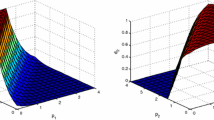Abstract
We use the concept of cartel stability defined by d’Aspremont et al. (Can J Econ 16(1):17–25, 1983) to obtain that the sequence of play between the cartel and the fringe affects cartel stability in a quantity-competition setting where firms tacitly collude. We also prove that an endogenous sequence of play between a cartel and a fringe depends on the discount factor. If the discount factor is large enough, the cartel and the fringe simultaneously choose quantities since the stable cartel may contain more firms under simultaneous play than under cartel leadership. This is due to the fact that under simultaneous play cartel firms have incentives to participate in the cartel because otherwise no collusion is possible.
Similar content being viewed by others
References
Albæk S (1990) Stackelberg leadership as a natural solution under cost uncertainty. J Ind Econ 38: 335–347
d’Aspremont C, Jacquemin A, Gabszewick JJ, Weymark JA (1983) On the stability of collusive price leadership. Can J Econ 16(1): 17–25
Davidson C, Deneckere R (1984) Horizontal mergers and collusive behavior. Int J Ind Organ 2: 117–132
Diamantoudi E (2005) Stable cartels revisited. Econ Theory 26: 907–921
Donsimoni M-P (1985) Stable heterogenous cartels. Int J Ind Organ 3(4): 451–467
Donsimoni M-P, Economides N, Polemarchakis H (1986) Stable cartels. Int Econ Rev 27: 317–327
Friedman JW (1971) A non-cooperative equilibrium for supergames. Rev Econ Stud 28: 1–12
Levenstein M, Suslow VY (2006) What determines cartel success?. J Econ Literat 44(1): 43–95
Lofaro A (1999) When imperfect collusion is profitable. J Econ 70(3): 235–259
Mailath GJ (1993) Endogenous sequencing of firm decisions. J Econ Theory 59: 169–182
Martin S (1993) Advanced industrial economics. Blackwell, Oxford
Morasch K (2000) Strategic alliances as stackelberg cartels—concept and equilibrium alliance structure. Int J Ind Organ 18: 257–282
Robson A (1990) Stackelberg and Marshall. Am Econ Rev 80: 69–82
Rothschild R (1999) Cartel stability when costs are heterogeneous. Int J Ind Organ 17: 717–734
Salant S, Switzer S, Reynolds R (1983) The effects of an exogenous change in industry structure on Cournot-Nash equilibrium. Quart J Econ 98(2): 185–199
Selten R (1973) A simple model of imperfect competition, where 4 are few and 6 are many. Int J Game Theory 2(3): 141–201
Shaffer S (1995) Stable Cartels with a Cournot Fringe. Southern Econ J 61: 744–754
Thoron S (1998) Formation of a coalition proof stable cartel. Can J Econ 31: 63–76
Thoron S (2004) Which acceptable agreements are equilibria?. Math Soc Sci 47: 111–134
Author information
Authors and Affiliations
Corresponding author
Rights and permissions
About this article
Cite this article
Escrihuela-Villar, M. A note on cartel stability and endogenous sequencing with tacit collusion. J Econ 96, 137–147 (2009). https://doi.org/10.1007/s00712-008-0053-8
Received:
Accepted:
Published:
Issue Date:
DOI: https://doi.org/10.1007/s00712-008-0053-8




